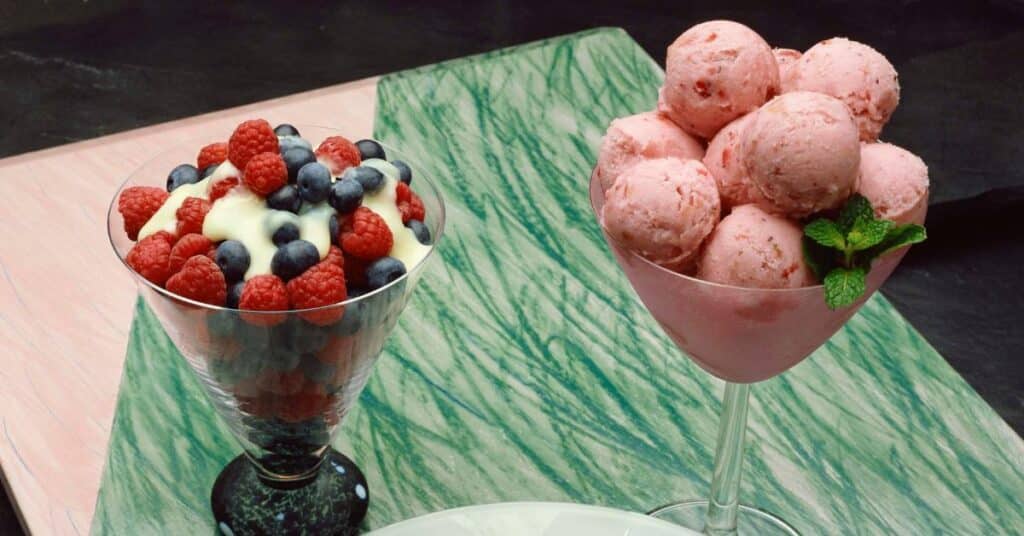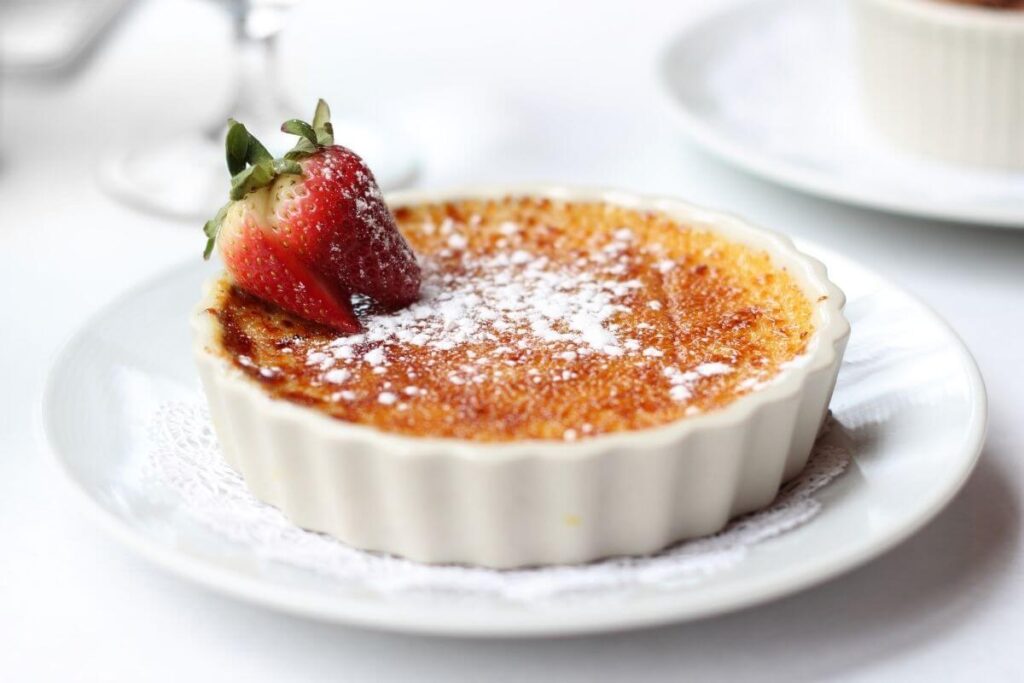
Ever wonder what is the difference between custard and ice cream? While they may seem quite similar, there are some subtle differences between the two. One thing is for sure…they are both delicious in their own right. Keep reading to discover what is the difference between custard and ice cream.
What Exactly is Custard?

Custard is a dessert known for its creamy texture and rich flavor. Made with milk, sugar, and egg yolks, it has a distinctive smooth and velvety consistency. It is served both hot or cold, depending on the recipe and preference.
Some variations of a typical custard recipe are:
- Traditional custard: Includes plain milk, sugar, and egg yolk mixture.
- Flavored custard: Flavors like vanilla, chocolate, fruit, and spices are added to enhance the taste.
- Pastry cream: A thicker version of custard that you use as a filling for all types of desserts, like cream puffs, other pastries, and pies.
What Exactly is Ice Cream?
I think it is a safe bet to say that Ice cream needs no introduction. As a beloved frozen treat, it typically consists of milk, cream, sugar, and flavorings. It’s churned while freezing, which incorporates air and helps achieve its distinctive texture.
Ice cream comes in more flavors than anyone could count, but nothing beats these three classic ice cream flavors: chocolate, vanilla, and strawberry. It also includes add-ins like nuts, fruit bits, chocolate chips, cookie dough….you name it.
Key Ingredients and Composition
Milk, Cream, and Sugar
In both custard and ice cream, the main ingredients include milk, cream, and sugar. However, their proportions differ slightly. For a richer taste and smoother texture, ice cream typically uses more cream than milk. On the other hand, custard uses a more balanced ratio of these two ingredients. The amount of sugar added to both custard and ice cream varies depending on the flavor and brand.
Egg Yolk is the #1 Difference
One of the key differences between custard and ice cream is egg yolks. Custard contains egg yolks, and ice cream does not. Egg yolks provide a richer flavor and a thicker, creamier texture to the custard, setting it apart from ice cream.
Fat Content
Another difference between custard and ice cream is their fat content. The butterfat in ice cream comes mainly from cream and gives it its silky, smooth texture. Ice cream generally has a higher fat content (around 10-20%) than custard, where the fat content ranges between 12-14%. It is both the egg yolks and milk and cream that make up custard’s fat content. Here is a quick breakdown of the key differences in the fat content:
- Ice Cream
- High-fat content: 10-20% butterfat
- Primarily contributed by cream
- Custard
- Moderate fat content: 12-14% butterfat
- Contributed by both cream and egg yolks
Texture and Consistency
Role of Air
The texture of custard and ice cream differs significantly due to the amount of air incorporated into them. In ice cream, overrun is an important factor that determines its air content. Overrun refers to the percentage of air added during the churning process, which affects the final product’s density and smoothness. Ice cream typically has a 50% to 90% overrun, while custard (frozen or otherwise) contains less air and is denser.
Churning Process
The way custard and ice cream are churned contributes to their differences in texture. When making ice cream, the churning process incorporates air and breaks up ice crystals, resulting in a lighter, more delicate dessert. While custard’s churning process is much slower, preventing it from becoming as airy and giving it a smoother, creamier texture.
Temperature and Freezing
Temperature and freezing methods play a crucial role in the consistency of custard and ice cream. Generally, custard is cooked at a higher temperature compared to ice cream, creating a thicker, creamier, and more pudding-like texture. Custard is also frozen at a warmer temperature than ice cream, limiting the formation of larger ice crystals and maintaining its velvety feel.
Flavors and Varieties
Popular Flavors
When it comes to custard and ice cream, you’ll find that many of the popular flavors overlap. The classics like vanilla, chocolate, and strawberry are available in both forms.
Since custard tends to have a richer and creamier texture, flavors like cinnamon and bacon really shine.
Unique and Seasonal Offerings
Custard and ice cream both feature unique and seasonal offerings that cater to adventurous palates. You’ll often find that both treats experiment with combining sweet and savory ingredients to create one-of-a-kind flavors.
- Custard: Look out for unique flavors like pumpkin pie during autumn and eggnog during the winter holidays.
- Ice Cream: Keep an eye on your local ice cream parlor for creative flavors like lavender, Earl Grey tea, or balsamic vinegar-infused fruits.
Finding the Best Soft Serve and Custard Shops
You can find both custard and ice cream in the freezer section of your grocery store, but if you’re after something homemade, visit local shops. To find the best one, ask for recommendations from family or friends, or look up online reviews. These shops usually offer creamier, fresher versions of your favorite icy treats compared to the store-bought options. At a local shop, you will typically find:
- A variety of flavors that change regularly
- Different cone options, such as waffle or sugar
- Add-on toppings like whipped cream, sprinkles, nuts, or fruit.
FAQs
What does custard taste like?
It has a smooth and velvety texture and a rich, indulgent flavor. Its taste is similar to a sweet, creamy pudding.
Which is healthier, custard or ice cream?
Custard is generally considered to be healthier because it is usually lower in fat and calories. Custard is typically made with milk while ice cream is usually made with cream which has a higher fat content than milk.

